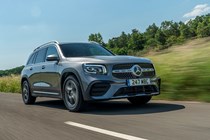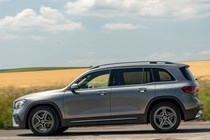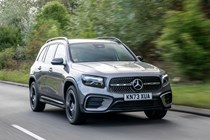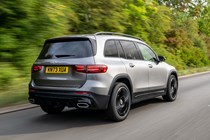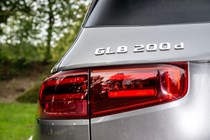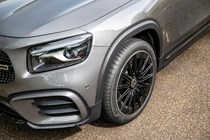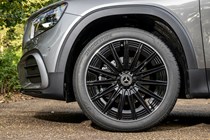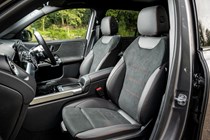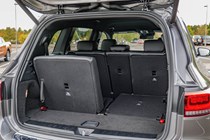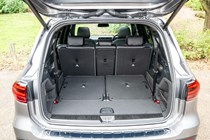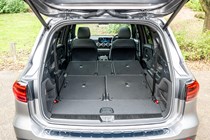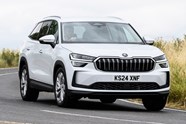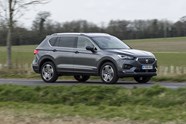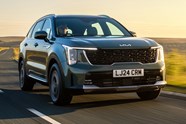
Mercedes-Benz GLB review
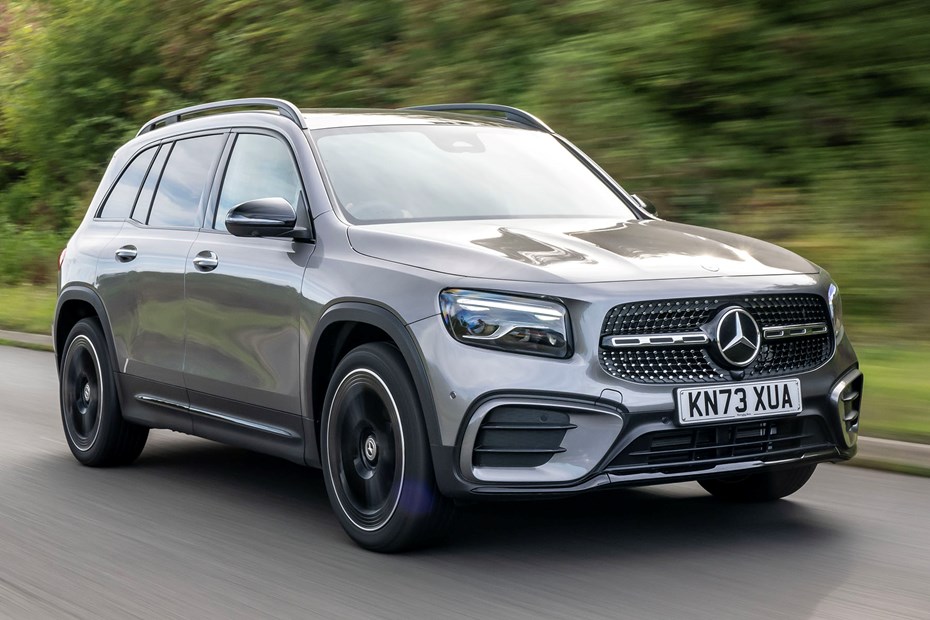
At a glance
| Price new | £39,160 - £53,685 |
|---|---|
| Used prices | £18,989 - £41,471 |
| Road tax cost | £190 - £600 |
| Insurance group | 24 - 35 |
Get an insurance quote with

|
|
| Fuel economy | 37.2 - 50.4 mpg |
| Range | 515 - 700 miles |
| Miles per pound | 5.5 - 6.4 |
| View full specs for a specific version | |
Available fuel types
Petrol
Diesel
Pros & cons
- Impressive, tech-laden cabin
- Rapid AMG performance version
- Decent standard equipment levels
- Third row best suited to children
- A lot of high-tech kit costs extra
- Not as flexible as more traditional MPVs
Mercedes-Benz GLB SUV rivals
Overview
The Mercedes-Benz GLB was a clever addition to the firm’s line-up when it was introduced in 2019 – and it remains a bit of a niche-buster to this day. It’s an SUV designed to slot between the GLA and GLC but, despite its relatively compact dimensions, Mercedes has somehow managed to squeeze a third row of seats into its cabin. We think this clever packaging makes it one of the best seven-seat SUVs you can buy.
Its seating capacity pits it against cars such as Peugeot 5008, SEAT Tarraco and Skoda Kodiaq, along with the plethora of seven-seat van-based MPVs from the Stellantis Group. However, none of its rivals offer the level of perceived prestige and desirability as the GLB.
You can even have a high-performance Mercedes-AMG GLB 35 4Matic variant, which further adds to car’s appeal. There are ciurrently no other mainstream SUVs that offer a similar combination of performance and accommodation. So, in that at least, the GLB is unique in its class – but that doesn’t necessarily mean it’s worth your cash.
We’ve driven the Mercedes-Benz GLB extensively, and you can find out more about how we test on Parkers via our dedicated explainer page. Here’s what we found when we tested all versions of the car on some of the country’s most demanding and busiest roads.
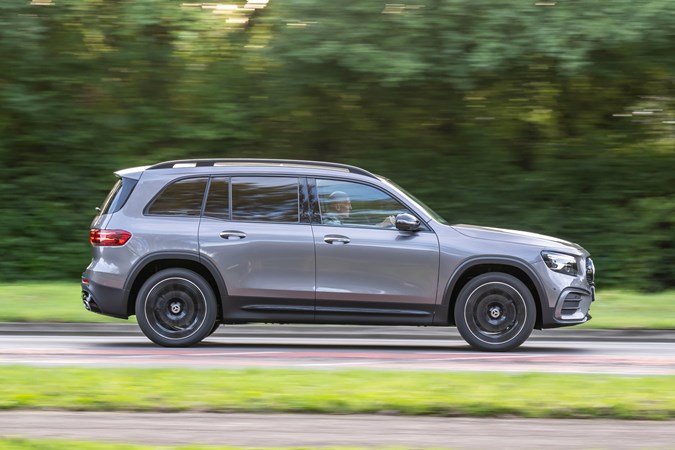
Practicality
Up front, the Mercedes-Benz GLB delivers a spacious cabin area that drivers and passengers of all sizes should be able to get comfortable in. Storage space is also ample, thanks to large door pockets, a sizeable locker under the centre armrest, a place to put your phone forward of the centre console and a reasonably proportioned glovebox.
This all standard fare for a car of this size, yet it’s when you climb into the second row of seats that the GLB really begins to impress. The feeling of outright space is considerable – certainly far, far more than you get in the Mercedes-Benz A-Class with which it shares much of its underpinnings. Footroom, kneeroom and legroom are all very generous and allow plenty of space for those in the outer rear seats. Of course, it’s not quite as generous as, for example, a Skoda Kodiaq, yet it feels much bigger than an Audi Q3.
The GLB’s second-row seats can also recline and slide forwards and backwards independently of one another, allowing greater legroom for those in the third-row seats in the case of the latter. Space in the rearmost seats is quite tight, but usable nonetheless.
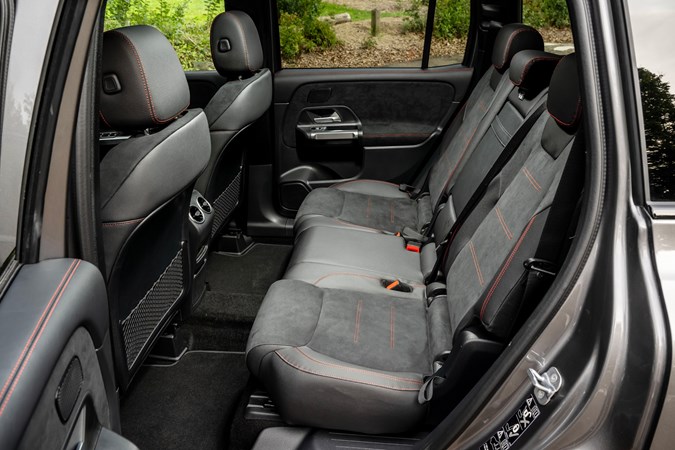
An average height male should be able to sit in relative comfort for around 30 minutes, however those any taller will find both head and legroom lacking. Climbing into the third row requires a certain amount of dexterity, too.
However, it’s important to note that in order to have any legroom in the third-row seats, the second-row bench must be slid forwards. This is the major differentiator from a larger seven-seat car, where those in the third row can be accommodated with little effect on those in the second.
Storage space in the back is workable, with large door pockets, nets behind the front seats, cupholders in the centre armrest and USB-C ports available. Meanwhile, those in the third row also get a small storage space on either side (with more USB-C connectivity) and cupholders in the middle. Isofix points are fitted as standard on the outer second row seats and third row seats.

Luggage and boot space
As for boot space, the GLB delivers a variety of measurements depending on whether you go for five or seven seats, and what configuration said seats are in. For example, opt for the latter, as most UK buyers will, and with all seats in place there’s 150 litres of luggage capacity on offer.
Fold the third-row of seats down and there’s 700 litres of space when loaded to the roof. Meanwhile, with both the third- and second-row seats down, 1,680 litres become available. Measurements for the five-seat version are 770 litres with all seats in place and 1,805 litres with the second row down. Note that boot space can also be increased depending on how far forward the second-row seat base and seat backs are adjusted.
Is it easy to park?
Measuring up at roughly 4.63 metres long and 1.83 metres wide, it’s noticeably bigger than the A-Class, so you won’t enjoy the same nimble feel in narrow urban streets and multi-story car parks, yet the view out is improved and allows you to see the end of the long bonnet.
A 180-degree rear view camera is fitted as standard, as is a handy spread of parking sensors around the car, plus you can build on this with Parktronic Active Parking Assist – allowing a full camera view of the car’s surroundings and automatic parking.
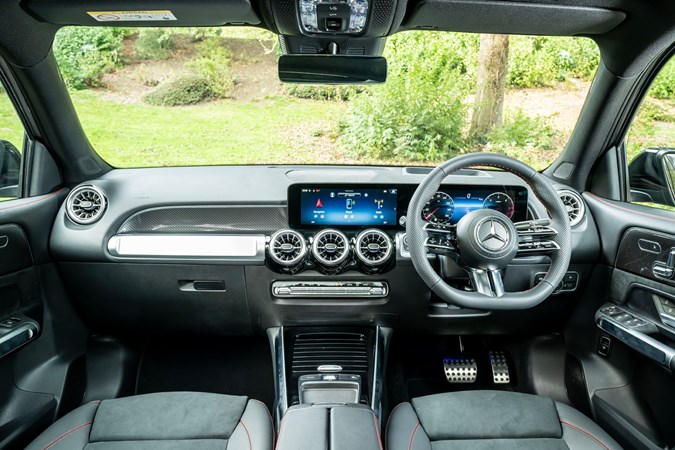
Interior
The GLB’s interior is very similar to the A-Class’s (and others based on the same basic structure), therefore, the order of the day is crisp, modern, mostly high quality materials, plus plenty of high-end technology on offer. However, certain elements of the cabin, such as the brushed metal grab handles on the doors, and more substantial facia directly in front of the passenger feel like nods to Mercedes’ G-Class SUV.
Much of the cabin’s design also depends on which trim level you go for. As well as cosmetic changes (AMG Line models upwards get a chunkier sports steering wheel for example), the two dashboard-mounted screens (arguably the centre point of the cabin) vary in size.
Infotainment and tech
The days of poorly-equipped Mercedes-Benzes is long gone. All GLBs come as standard with Cruise control, twin-zone climate control, 180-degree reversing camera, heated front seats, light and sight interior lighting package, sat-nav, and Apple CarPlay/Android auto.
Sport and AMG Line versions make do with the 7.0-inch digital instrument cluster and 7.0-inch infotainment screen, while AMG Line Premium models an up get the full 10.25-inch monitors. And while both iterations run the same MBUX software, it’s clear that the GLB cabin has been designed to work best with the larger screens.
MBUX is becoming more familiar throughout the Mercedes-Benz range, with its sharp graphics, speedy processor and seemingly endless functionality – not to mention its ‘Hey Mercedes’ voice activation (that works like Siri, but in your car) and Mercedes me connect. Smart as it is, however, we still reckon that equivalents systems from Audi and BMW are easier to navigate with simpler controls.

Mercedes-Benz GLB engines
The Mercedes-Benz GLB is available with a range of four engines – two petrols and two diesels – with a choice of either front- or all-wheel drive. All models come as standard with either an eight- or seven-speed dual-clutch automatic transmission. Unlike the A-Class and GLA, there’s no plug-in option here – although you could plump for the Mercedes-Benz EQB if you want an electric alternative.
If you want a petrol, there’s the choice between the entry-level front-wheel drive GLB 200 and the performance-focused AMG GLB 35 4Matic, the latter of which we’ll discuss in more detail further down the page. Power is 163hp with 250Nm of torque, good for 0-62mph in 9.1 seconds and a top speed of 129mph. Note that this is the only GLB variant to come with a seven-speed dual-clutch automatic, as opposed to the rest that use an eight-speed.
Diesel models are the GLB 200d and GLB 220d. The former is available with both front- and all-wheel drive, and produces 150hp and 320Nm of torque. That’s enough for 0-62mph in 9.0 seconds and a top speed of 127mph. If that’s not enough and you fancy the 220d, output is increased to 190hp and 400Nm of torque, bringing the 0-62mph time down to 7.6 seconds and top speed up to 135mph. 4Matic all-wheel drive is also standard with the 220d.
We’ve reckon the 220d and reckon it does everything you need in a seven-seat SUV. Power and torque are plentiful, with performance feeling brisk even when loaded up with occupants and luggage. Granted, it’s a touch noisier than you might expect yet the GLB’s sound deadening does a reasonable job of drowning out the worst of it.

What’s it like to drive?
Seven-seat cars aren’t usually the most exciting to drive as the emphasis is on safety and predictability. With this in mind, the GLB does a decent job of combining the two. It’s obviously heavier and taller than the A-Class on which it’s based, yet there’s still a pleasing amount of agility on offer – both at high and low speeds.
Optional 4Matic all-wheel drive also allows for strong traction on wet roads, with the standard power split being 80% of drive sent to the front and 20% to the rear, however this does automatically adjust depending on grip levels. Various drive modes also mean you can adjust the weight of the steering from light (ideal for city driving) to heavier (better for motorways and twisty country roads).
If you want to take the GLB off-piste, the optional Off-Road Engineering Package (standard-fit in the UK) brings an additional drive mode for the rough stuff, gradient and inclination angle info on the media screen and downhill speed regulation that helps retain control when driving down steep hills.
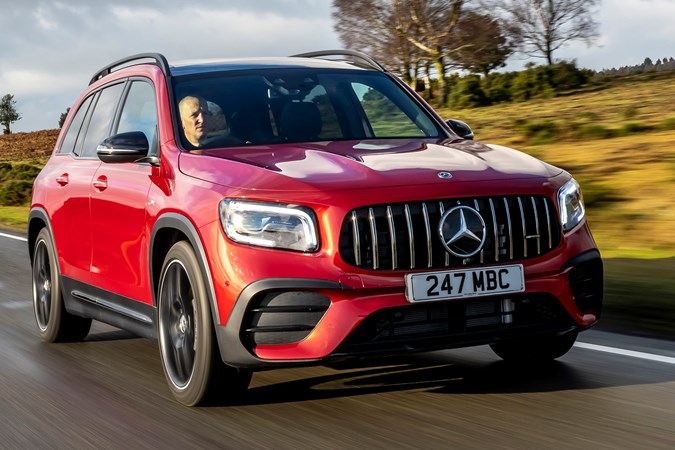
What’s the hotter A35 like to drive?
For performance fans in need of seven seats, the Mercedes-AMG GLB 35 is almost in a class of its own, thanks to the dearth of obvious alternatives. Packing a 306hp 2.0-litre turbocharged petrol engine, there’s always a strong turn of speed when required despite the 1.7-tonne kerb weight.
Acceleration from 0-62mph takes 5.2 seconds, with top speed rated at 155mph. The gearbox can be a little slow to respond sometimes, yet you can learn to work around it and adapt the drive modes settings accordingly. It makes a decent sound, too, with an entertaining induction whoosh from the turbocharger when accelerating in gear.
Opt for the Mercedes-AMG GLB 35 4Matic and handling is largely the same as the regular car, but with a few bits sharpened up. The brakes, for example, do an excellent job of scrubbing speed off into corners, while body control is tighter (where the body of the car leans less on the chassis through corners) and the steering feels a touch more direct. It’s not as much fun as an A35, yet it is surprisingly capable and the idea of hurtling along in a seven-seat ‘off-roader’ is a childishly amusing one in itself.
Comfort
Naturally, both the driver and passenger sit high up in the GLB’s standard driving position. There’s a broad range of adjustment in both the seat and steering wheel, too, meaning occupants of all heights shouldn’t have any problem getting comfortable. Visibility is good too, with the car’s boxy profile allowing a mostly uninterrupted view out from all angles.
European cars are optionally available with adaptive suspension, but the only GLB available in the UK with that tech is the performance AMG 35 variant (see below). The regular variants have fixed, or passive, suspension which is perfectly agreeable for UK roads providing you steer clear of the biggest 19- and 20-inch alloy wheels. The bigger alloys make the ride unnecessarily firm, so stick with the standard 18-inch wheels.
Engine refinement is in line with other Mercedes-Benz vehicles – good, but not quite as smooth-sounding as BMW and Audi equivalents, while wind noise in the GLB is a notch up on the A-Class, but still largely unintrusive.

Ownership and running costs
The GLB delivers impressive claimed fuel economy figures across the range. The most frugal option is the front-wheel drive 200 d, which Mercedes says can return up to 50.4mpg. Even the petrol variants aren’t bad considering the size and weight of the car, though, with the 200 and AMG 35 4Matic models returning up to 40.4mpg and 31.0mpg respectively in WLTP tests.
In the real world, you can expect to get between 5.5 - 6.4 mpp (miles per pound), which is more than acceptable for an SUV of this size. Unsurprisingly, the diesel will go a lot further for your money than the petrol version.
Being a Mercedes-Benz, servicing and parts will be pricier than a non-premium manufacturer, however you should expect a higher standard of customer care at the dealership. Residual values for the GLB are yet to be confirmed.
Reliability
We’re around five years into the GLB lifecycle and we haven’t heard any horror stories yet. Drivers commenting in our owner reviews section also give a largely positive report of the car’s reliability. This was expected, though, because it shares many mechanical parts (and a platform) with the big-selling Mercedes-Benz A-Class. Mercedes hasn’t issued any recalls for the car, either.
If you buy one, you might want keep an eye on the interior. A-Class owners report poor build quality and rattly trims. But the cars we’ve driven feel more heavy duty than the A-Class, with a pleasing solidity to most buttons and controls – the cheap and tacky feeling stalks on the steering column being a notable exception. Like all Mercedes-Benz models, the GLB comes with an unlimited-mile three-year warranty.
Safety
Given Mercedes’ enviable safety record, it was no surprise that the GLB scored a full five-star rating when it was tested by Euro NCAP in 2019. This is because the GLB shares a platform with the A-Class and B-Class, both cars that have achieved the maximum score.
Standard safety equipment on the GLB includes autonomous emergency braking, Active Bonnet (improves pedestrian safety, Active Lane Keeping Assist, Attention Assist (monitors the driver for drowsiness) and an eCall emergency call button (built in SOS button, also capable of automatically contacting emergency services and alerting them to the vehicle’s location in the event of a serious accident).
The optional Driving Assistance Pack (also standard on AMG Line Premium Plus) adds Active Distance Assist Distronic (similar to adaptive cruise control), Active Speed Limit Assist in conjunction with Traffic Sign Assist (recognises road signs and optionally adjust the speed limit accordingly) and route-based speed adjustment (for example, reduces speed when Distronic is activated and vehicle is approaching a roundabout).
Also fitted – in conjunction with the Multibeam LED headlamps – is the off-road light that’s permanently switched on up to 30mph and helps highlight obstacles in the rough terrain. Like most ‘off-roaders’ of this ilk, the GLB does have its limits, however they’re likely to be far higher than most customers will ever need. Needless to say, we reckon this is a very safe place for you and your family/
What models and trims are available?
The GLB is available with four trim levels, aside from the AMG GLB 35, ranging from entry-level Sport, AMG Line, AMG Line Premium and AMG Line Premium Plus. All versions get sat-nav, a reversing camera, heated half leather front seats, dual-zone climate control and cruise control as standard, yet we reckon the spec to aim for is AMG Line Premium or above. With this, you get the larger 10.25-inch central infotainment screen and digital cockpit display, both of which help to lift what is already an exceptional cabin.
Standard safety features are also extensive, and include Active Brake Assist (a form of autonomous emergency braking), Active Bonnet (improves pedestrian safety), Active Lane Keeping Assist, Attention Assist, Speed Limit Assist and the eCall emergency call system, capable of automatically alerting the emergency services if you’re involved in an accident.
But does this combination of a desirable badge and cutting edge technology make the GLB a recommended choice for anyone looking for a mid-size premium seven-seater? Should you buy one, or just go for a larger and more mainstream family-friendly SUV instead? Read on for our verdict to find out.



